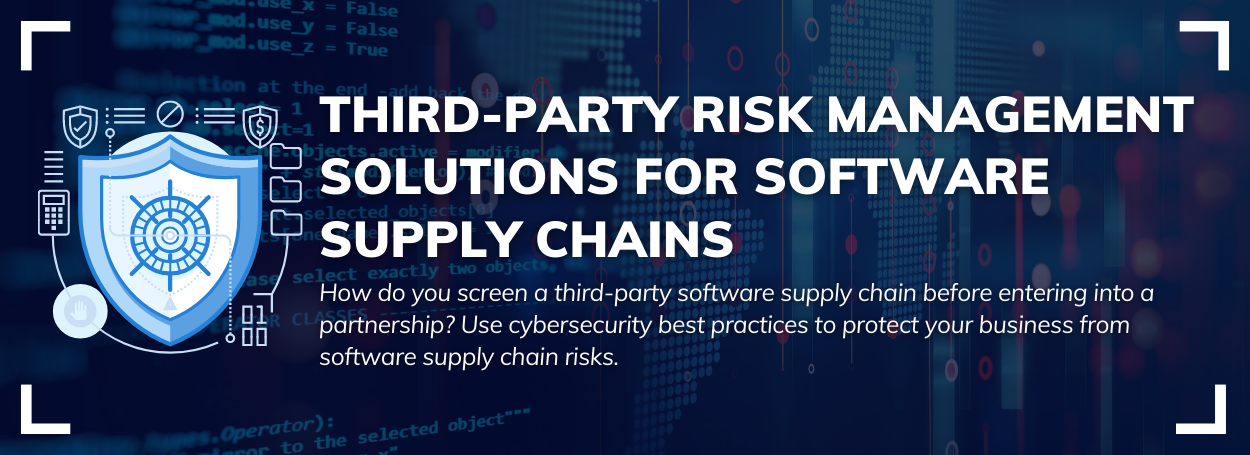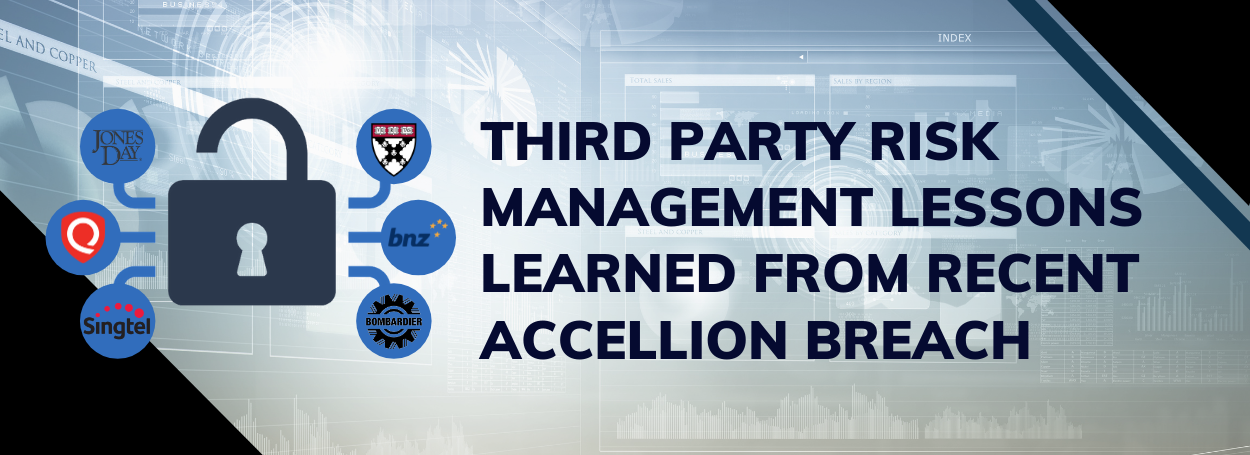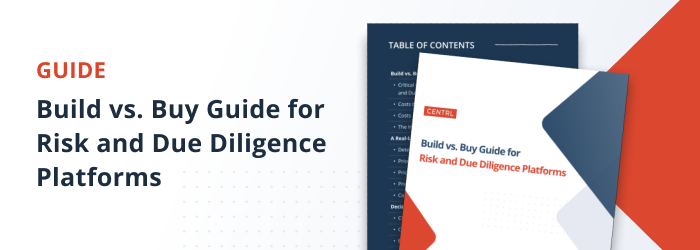Third-Party Risk Management Solutions for Software Supply Chains

How do you screen a third-party software supply chain before entering into a partnership? Use cybersecurity best practices to protect your business from software supply chain risks.
Software solutions come with many benefits for businesses. They boost employee productivity and efficiency, besides improving its bottom line. Software and digital solutions streamline business processes and workflows, automate specific business functions, and make it easier for your staff to manage day-to-day activities.
While your software vendors help make your business more profitable, they can expose your organization to cybersecurity threats.
Your Software Vendors Can Expose You to Cybersecurity Risks
Choosing and onboarding new software supply chain members may seem easier today, but do you know that not all software vendors are fully secure? As a result, cybercriminals can use the vulnerabilities and loopholes in your software supply chain and even your vendors’ products to access your data, systems, and networks?
According to Ponemon Institute research, 51 percent of companies have had a data breach triggered by one of their contractors or third-party providers. Given the tremendous repercussions of a possible breach, as well as the fact that phishing efforts and other cyber risks have increased as a result of the Coronavirus pandemic, assessing a potential new vendor’s cybersecurity posture before onboarding is more important than ever.
From an IBM and Ponemon Institute analysis, the average cost of a data breach increased from $3.86 million to $4.24 million between 2020 and 2021. Moreover, the financial damage is compounded when it comes to third-party data breaches, with an average cost of $4.33 million.
The sweeping software supply chain attack known to date happened in December 2020 when Russian state-sponsored cybercriminals attacked SolarWinds. The malicious actors trojanized software updates to Orion, an IT monitoring and management application from SolarWinds. In a matter of days, dozens of companies and government agencies, including Microsoft, reported that they were affected by the cyberattack.
While software supply chain may sound like an excellent term to describe your third-party digital vendors, it is a significant cybersecurity phrase. This is because you’re only as secure as the most vulnerable link in your digital supply chain.
Therefore, it is crucial for businesses and other organizations to choose their software vendors exceptionally carefully. This is where Third-Party Risk Management solutions have got your back!
How to Manage Third-Party Risk in Your Supply Chain
Companies must follow the advice of the National Institute of Standards and Technology (NIST) on digital supply chain risk management. The institute emphasizes that organizations identify, assess, and mitigate risks related to software and digital product supply chains’ scattered and interconnected nature.
Vulnerabilities in the complete lifecycle of software, from design to development and deployment to maintenance, can expose your business to cyber threats at any stage.
The surprising part is that even though most companies say that they’re aware of the threats, most of them acknowledge that supply chain security is not among their priorities.
Also, according to a report by Gartner, while supply chain leaders keep cybersecurity threats on their priority list, only 10 percent think that their functions have a strategic link with information technology.
It is time for organizations to prioritize supply chain risk management and choose their third-party software vendors judiciously.
Read on to learn how a reliable third-party risk management solution can help you select your software vendors and mitigate the threats.
Choosing a Solution to Manage Software Supply Chain Risks
A robust and versatile third-party risk management solution will allow you to collect your software supply chain data and automate the evaluation process. It will give you complete control over the supply chain risk management operations.
Here’re the key features to look for in a supply chain risk management platform for your software vendors:
One-Window, Centralized Supply Chain Inventory
A reliable third-party risk management software will allow you to manage all of your software supply chain members’ information in a single place. For example, you can quickly access your vendor documents, policies, and risk profiles in a dedicated cloud-based directory.
In addition, it will categorize the risk into different threat levels, from critical to less severe risks. As a result, you’ll be able to view and manage each supply chain member’s risks, information, and other elements at the product and service engagement levels.
Choose and Onboard Secure Vendors
A good risk management solution will organize the pre-boarding risk assessment for new vendors by transmitting vendor analysis questionnaires to the responsible staff. Your team members can then group the potential vendors into multiple risk levels to perform a detailed assessment of their due diligence, control protocols, and cyber defenses.
Risk, Audit, and Monitoring Automation
Manual risk assessment, audit, and monitoring are overwhelming, draining, and ineffective.
Therefore, your organization needs a platform to manage and automate these tasks. Make sure to pick a third-party risk management solution that automates critical activities with unified industry standard templates, such as AITEC and SIG. Or you could choose software that allows you to upload your risk assessment, audit, and monitoring templates to the system.
You can use pre-filled templates and surveys with answers from your vendors to monitor the changing factors. A dependable software will also let you monitor vendor assessment progress, besides managing the deadline and review statuses.
A Solid Response Application for Vendors
Your vendors should be able to access your risk management platform. By collaborating with your supply chain members and vendors, you can monitor their progress and enhance reporting.
In addition, it will eliminate incongruent monitoring processes, bringing every stakeholder on the same page.
Effective Third-Party Response Assessment
Using the supply chain risk management platform, you can assess your vendors’ responses using various criteria. It is a good idea to pick software that allows you to use auto-scoring to allocate modules or questions to multiple experts for assessment.
More Features
In addition to the above-explained features, a solid and reliable third-party vendor management tool will let you:
- Identify, manage, and track problems and risks until resolution
- Develop and execute action plans
- Get actionable risk insights and monitor supply chain risk trends with analytics
- Perform cross-vendor comparisons
- Run deep searches to locate relevant information and documents quickly
The Benefits of Third-Party Risk Management Software
Historically, security teams used yearly security assessments to determine continuing third-party risk. This strategy, however, presents significant obstacles to security officers.
Assessments take a long time. With some surveys containing thousands of questions and many businesses collaborating with hundreds or thousands of third parties, assessments can consume a significant amount of time and resources to create, fill out, evaluate, and analyze after they are returned.
Due diligence is insufficient—a single round of due diligence when third-party onboarding vendors is inadequate for managing corporate risk. In addition, security and dangers evolve at a rapid pace. As a result, potentially severe security events or changes in security posture may occur between evaluations without your notice.
There are many benefits in the use of Third-Party Risk Management (TPRM) Software, but the biggest ones are:
Centralized Third-Party Risk for all Suppliers
Using Third-Party Risk Management Software consolidates your program procedures and organizes them through established standards. As a result, all the information related to your suppliers, providers, and other third parties will be on a single platform as a single source of truth for your internal and external audits.
Automate Onboarding, Assessment, and Re-Certification
You most likely have a lot on your shoulders already. However, in the day-to-day operations of your vendor risk management program, there are several things to remember and activities to complete.
Using Vendor Risk Management (VRM) software helps you automate due diligence and monitoring procedures, eliminating the need to worry about missing crucial deadlines or failing to perform required supervision operations.
Continuously Monitor Existing and Emerging Risks
Continuous monitoring provides you with up-to-date information about the security posture of your third-party vendors. Instead of a calendar date, actions such as a change in security rating or an applicable regulatory change might necessitate an evaluation.
This guarantees that the assessment is prompted by the need to perform one and perhaps avoids unacceptable risk from being introduced into the third-party environment merely because it isn’t yet time for reassessment.
Identify the Vendors that Pose the Most Risk
Having all the information of your vendors not only helps you ease the assessment process but help you see the risk level of each third party. This lets you know which ones are outside your company’s risk appetite and tolerance levels.
Why Choose Vendor360 for Software Supply Chain Risk Management
CENTRL’s Vendor360 provides you with a robust and centralized platform to manage the risks emanating from all of your supply chain members, including software vendors. This vendor risk management software not only makes the vendor selection and onboarding process a breeze but also fully secure, with continuous monitoring and automation tools.
Our cutting-edge, cloud-based software simplifies cybersecurity risk assessments. It can create an evaluation template for repetitive usage with comprehensive customization.
Vendor360 may be used to manage assessment progress, establish deadlines, and check questionnaire progress throughout your third-party portfolio. In addition, the product offers an easy-to-use user interface, powerful automation, and analytics dashboards.
Automate your software supply chain risk assessment, audit, and monitoring with Vendor360. Act now to streamline your vendor response assessment process and ensure business continuity.
Request a demo to learn more about Vendor360.

